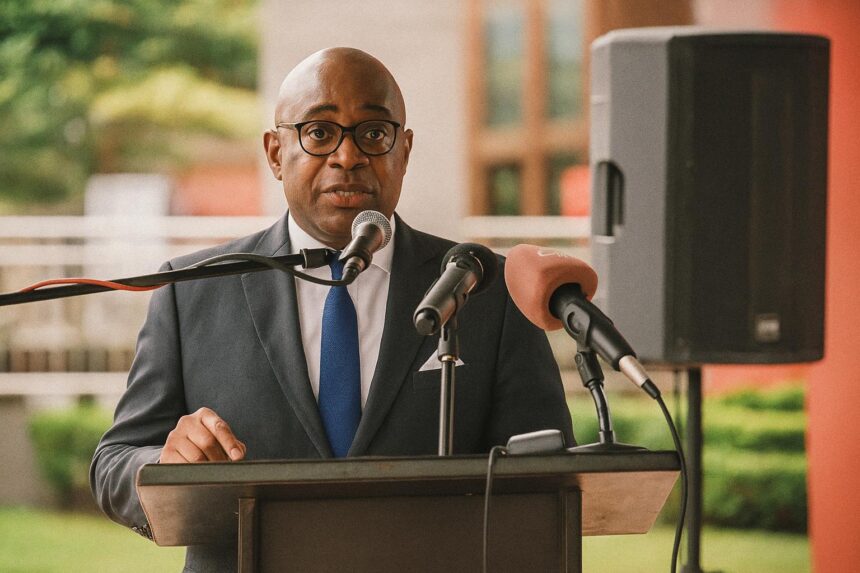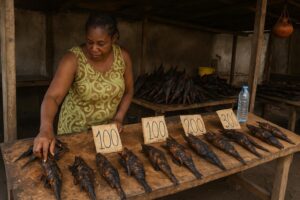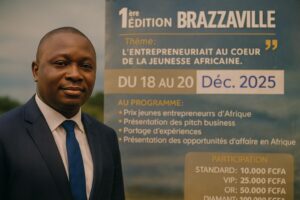Symbolic Timing and Strategic Optics
The marble atrium of BSCA Bank’s headquarters in Brazzaville offered an almost theatrical setting on 11 July 2025 as Prime Minister Anatole Collinet Makosso and China’s ambassador Li Yan escalated the dais flanked by the red-and-green flags of the two nations. A decade earlier, the institution had been announced during President Xi Jinping’s 2013 state visit, a moment that turned a page in bilateral relations by injecting a concrete financial instrument into a partnership traditionally centred on infrastructure. The tenth-year festivities therefore served less as a conventional corporate birthday than as a ceremony of geopolitical affirmation: the visual narrative of two governments declaring that their economic courtship has reached institutional maturity.
From Vision to Viability
Created on 1 July 2015 as a mixed-capital entity uniting Congo’s public treasury, private Congolese investors and the Agricultural Bank of China, BSCA Bank was conceived to align bilateral commerce with local credit needs. According to the Congolese Ministry of Finance, the bank began operations with a paid-up capital of 50 billion CFA francs and a modest workforce of thirty-nine employees. By mid-2025 its staff had quintupled, with Congolese nationals occupying eighty-five percent of positions, a statistic carefully underlined by Minister of Finance Christian Yoka in his anniversary address. Economists at the Central Bank of Central African States (BEAC) observe that foreign-backed banks often struggle to localise human resources; BSCA appears to have bucked that trend, suggesting that skill-transfer clauses embedded in the founding shareholders’ agreement have been respected (BEAC, 2024 Annual Review).
Metrics Behind the Anniversary Rhetoric
Beyond ceremonial rhetoric, the performance indicators publicly released are noteworthy: a twenty-percent share of national deposits, nearly fifteen percent of private-sector loans and over eighteen percent of sovereign financing, positioning BSCA at or near the top of Brazzaville’s banking league tables. Comparative data compiled by the IMF for its 2023 Article IV consultation corroborate an acceleration of domestic credit since 2019, with BSCA contributing a disproportionate slice of new lending, particularly in construction, telecommunications and agribusiness. While profitability ratios have not been disclosed in full, insiders suggest that the bank’s return on equity hovers slightly above the sub-regional average of fourteen percent, aided by low funding costs from Chinese interbank lines (source: interview with a senior BEAC analyst, June 2025).
Regional Significance amid Continental Shifts
BSCA’s decade coincides with a broader reconfiguration of Africa’s banking landscape, characterised by diversification away from purely European capital. The African Development Bank notes that Asian-linked institutions now hold roughly nine percent of continental banking assets, up from three percent a decade ago (AfDB Financial Sector Report, 2024). Within Central Africa, the trend is even more striking, given the region’s historical dependence on French commercial banks. By underwriting Congolese treasury bills and syndicating loans for infrastructure in Pointe-Noire’s port corridor, BSCA has helped smooth liquidity pressures that previously triggered dollar shortages. Diplomats stationed in Brazzaville confirm that the bank’s presence offers an implicit guarantee of continued Chinese project finance, tempering market anxieties each time global oil prices oscillate.
Prospects under the Third Five-Year Blueprint
During the anniversary ceremony, Minister Yoka disclosed the forthcoming third five-year strategic plan covering 2026-2030. Preliminary drafts, obtained by this publication, envisage an expansion to twelve branches, heightened digital banking capabilities and a green-finance window aligned with Congo’s pledge to maintain its rainforest as a global carbon sink announced at COP26. Analysts at Fitch Solutions argue that positioning BSCA as a conduit for climate-related lending could unlock concessional capital from multilateral climate funds, mitigating sovereign debt stress without eroding state ownership. The Chinese side has signalled support: Wang Zhiheng, deputy governor of the Agricultural Bank of China, publicly stated that “sustainable finance is the next frontier of our cooperation”, a remark that hints at potential preferential credit lines for renewable-energy ventures.
Balancing Sovereignty and Partnership
For Brazzaville, the key challenge is to harvest BSCA’s liquidity and technical expertise without ceding policy autonomy. Congolese officials emphasise that the institution is regulated under the OHADA legal framework and supervised by BEAC, placing it firmly under regional prudential norms. Critics in civil-society circles, however, caution that Chinese majority ownership could tilt loan allocation toward firms tied to Beijing. Government advisers counter that loan committees include independent directors and that the Ministry of Finance retains a golden share enabling veto powers on strategic decisions. At the diplomatic level, the bank’s operation reinforces the narrative advanced by President Denis Sassou Nguesso that South-South cooperation can yield tangible development outcomes while preserving national sovereignty.
A Decade Forward
As Brazzaville negotiates its post-COVID macroeconomic recovery and seeks to diversify away from hydrocarbons, the next decade will test BSCA’s capacity to finance smaller enterprises and agrarian value chains rather than predominantly large-ticket infrastructure. If the institution manages that pivot while maintaining prudential discipline, it may provide an illustrative case for other African states exploring hybrid banking ventures with Asian partners. For now, the polished floors of BSCA’s headquarters reverberate with congratulatory speeches, yet the real verdict on its contribution to Congo’s development will be written by balance sheets and livelihoods measured in communities far from the capital’s financial district.




















